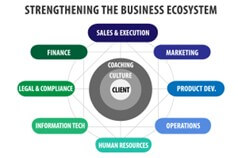
Does your sales process generate predictable results? Check out these tips that will bring you more sales process efficiency and WINS!
We’ve all encountered that one prospect who shows strong buying signals, but then the deal doesn’t close as anticipated. The initial conversation goes great, you verify good alignment and genuine interest, but when you follow up there’s a noticeable change in engagement.
If you fail to get to the bottom of your prospect’s change in heart, they tend to become unresponsive, or in worse case…. you get ghosted! For those of us with years of selling experience, we understand you can’t ‘win ‘em all’. But… if you’re finding your deals are regularly stalling, it’s time to examine your sales process.
We all have a sales process, whether you’re a solopreneur securing your own work or a salesperson representing a fortune 500 company. The question is how strategic is its design and how disciplined and skilled are you at following it?
For some, a sales process is navigated through post-it notes all over their desk, car, and mirrors at home. For others, it’s a cookie cutter 4-step process that came auto-loaded in their Customer Relationship Management (CRM) system.
Those who have invested time developing an intentional, custom sales process, aligned with their unique product offering and buyers’ journey are the ones who reap the benefit of sales predictability.
In an effort to share opportunities for improvement that I help my clients implement every day, I’ve put together some tips that I hope can also bring you more sales process efficiency, control, and WINS!
Getting Started
- Reflect – If you’re starting from scratch, start by reflecting on the interactions you’ve had with prospects leading up to them making a buying decision, whether you won the deal or not. Ask yourself, “What were the common phases I saw them process through to form their decision?”. These will become the stages within your sales process.
- Easy – When developing a sales process for yourself or building one for your sales team to follow, keep it simple. Use comprehensive terminology that is common to your environment. This will help you – and your sales team – master the steps quickly and turn the process into a game changer for success.
- Customize – If you use a Customer Relationship Management system (CRM), you’ll find it has pre-loaded sales stages. It’s important that you take the time to customize them by using the tips I shared above. Too often I meet with companies who have adopted cookie-cutter CRM stages as their method of guiding a prospect. This results in stalled deals because they haven’t accounted for the appropriate steps that correlate with their unique sales environment.
Building out the Sales Stages
- Define Objectives – After your sales stages have been established, clearly define the objective for each one. Be careful not to confuse activities you may do within a particular sales stage with its objective. Think of the objective as the core purpose for each stage within the overarching sales process. For example, calling a client is an activity, but confirming the client has budget is an objective.
- Key Activities & Information – Lay out the key activities you’ll focus on and/or key information you desire to collect from the buyer at each sales stage of your sales process. These items may take time to obtain, but the idea is that each piece of information enables you to get a better understanding of the buyer’s objectives, buying criteria, and motivators for taking action.
- Pass-through Gates – Now it’s time to pinpoint the one thing to achieve or collect in each sales stage that is more imperative than anything else. This is a key activity or piece of information that assures you’re on the best footing possible before you progress onto the next stage. For example, a pass-through gate could be verifying that you are interacting with the contact who has signing authority versus a support resource who has been assigned to collect bids.
Buyer/Seller Alignment
One of the largest ‘deal killers’ I see is when the seller is not aligned with their buyer. Too often the seller is moving too fast and is unaware that the buyer is lagging behind- for whatever reason.
The seller needs to pace the sales process to the buyer’s readiness for each next step. When they don’t, the seller doesn’t come off as genuine- just focused on closing the deal quickly. Leaving that impression is sure to diminish relationship trust and slow down or kill the deal.
Create check-in points in your sales Process to gauge how your buyer is processing the new information they are taking in. Be curious by asking insightful, open-ended questions to explore how they are viewing your solution fit with their needs.
Create a relationship where they feel comfortable verbalizing what they don’t like or what they may perceive as a stronger fit with a competitor. You cannot overcome objections you don’t know exist.
Predictability & Confidence
When you have a strong understanding of your deal’s positioning throughout the sales process, not only will you be confident in your ability to close the opportunity, but your company will have a predictable forecast.
In today’s supply chain and labor shortage environment, trustworthy projections are critical in the company’s ability to deliver on customer expectations.
The best way to monitor your sales process effectiveness is through an insightful sales dashboard, commonly referred to as a scorecard. This article, “Does Your Sales Dashboard Provide Powerful Insight?” is a helpful resource to learn about the key sales activities that drive results and how to monitor them.

As a Fractional or Outsourced VP of Sales, my specialization is in sales organization development and leadership. We both play a pivotal role in the business ecosystem as we help our clients succeed.
Contact me today at (404) 245-3775 or rob@osxsales.com for help establishing a sales process that works!